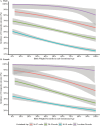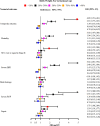Association of neonatal outcome with birth weight for gestational age in Chinese very preterm infants: a retrospective cohort study
- PMID: 39367446
- PMCID: PMC11451004
- DOI: 10.1186/s13052-024-01747-1
Association of neonatal outcome with birth weight for gestational age in Chinese very preterm infants: a retrospective cohort study
Abstract
Background: The neonatal outcomes across different percentiles of birth weight for gestational age are still unclear.
Methods: This retrospective cohort study was conducted within 57 tertiary hospitals participating in the Chinese Neonatal Network (CHNN) from 25 provinces throughout China. Infants with gestational age (GA) 24+0-31+6 weeks who were admitted within 7 days after birth were included. The composite outcome was defined as mortality or any one of neonatal major morbidities, including necrotizing enterocolitis (NEC), bronchopulmonary dysplasia (BPD), severe intraventricular hemorrhage (IVH), cystic periventricular leukomalacia (cPVL), severe retinopathy of prematurity (ROP), and sepsis. Multivariable logistic regressions using generalized estimating equation approach were conducted.
Results: A total of 8380 infants were included with a mean GA of 30 (28-31) weeks. Of these, 1373 (16.5%) were born at less than 28 weeks, while 6997 (83.5%) had a GA between 28 and 32 weeks. Our analysis indicated that the risk of composite outcomes was negatively associated with birth weight for gestational age, and compared to the reference group, the multiple-adjusted ORs (95%CI) of composite outcomes were 4.89 (3.51-6.81) and 2.16 (1.77-2.63) for infants with birth weight for gestational less than 10th percentile and 10th -30th percentile, respectively. The ORs (95%CI) of mortality, NEC, BPD, severe ROP, and sepsis in infants with birth weight for gestational age at 10th-30th percentile were 1.94 (1.56-2.41), 1.08 (0.79-1.47), 2.48 (2.03-3.04), 2.35 (1.63-3.39), and 1.39 (1.10-1.77), respectively.
Conclusion: Our study suggested that the risk of adverse neonatal outcomes increased significantly when the birth weight for gestational age was below the 30th percentile. Regular monitoring and early intervention are crucial for these high-risk infants.
Keywords: Birth weight for gestational age; Health outcomes; NICU; SGA; Very preterm infants.
© 2024. The Author(s).
Conflict of interest statement
The authors report no conflict of interest.
Figures
References
-
- Arifeen SE, Black RE, Caulfield LE, et al. Infant growth patterns in the slums of Dhaka in relation to birth weight, intrauterine growth retardation, and prematurity. Am J Clin Nutr. 2000;72(4):1010–7. 10.1093/ajcn/72.4.1010. [published Online First: 2000/09/30]. - PubMed
-
- Ding G, Tian Y, Zhang Y, et al. Application of a global reference for fetal-weight and birthweight percentiles in predicting infant mortality. BJOG: Int J Obstet Gynecol. 2013;120(13):1613–21. 10.1111/1471-0528.12381. [published Online First: 2013/07/19]. - PubMed
-
- Piro E, Serra G, Schierz IAM, Giuffrè M, Corsello G. Fetal growth restriction: a growth pattern with fetal, neonatal and long-term consequences. Euromediterranean Biomed J. 2019;14(09):038–44.
Publication types
MeSH terms
LinkOut - more resources
Full Text Sources
Medical




